
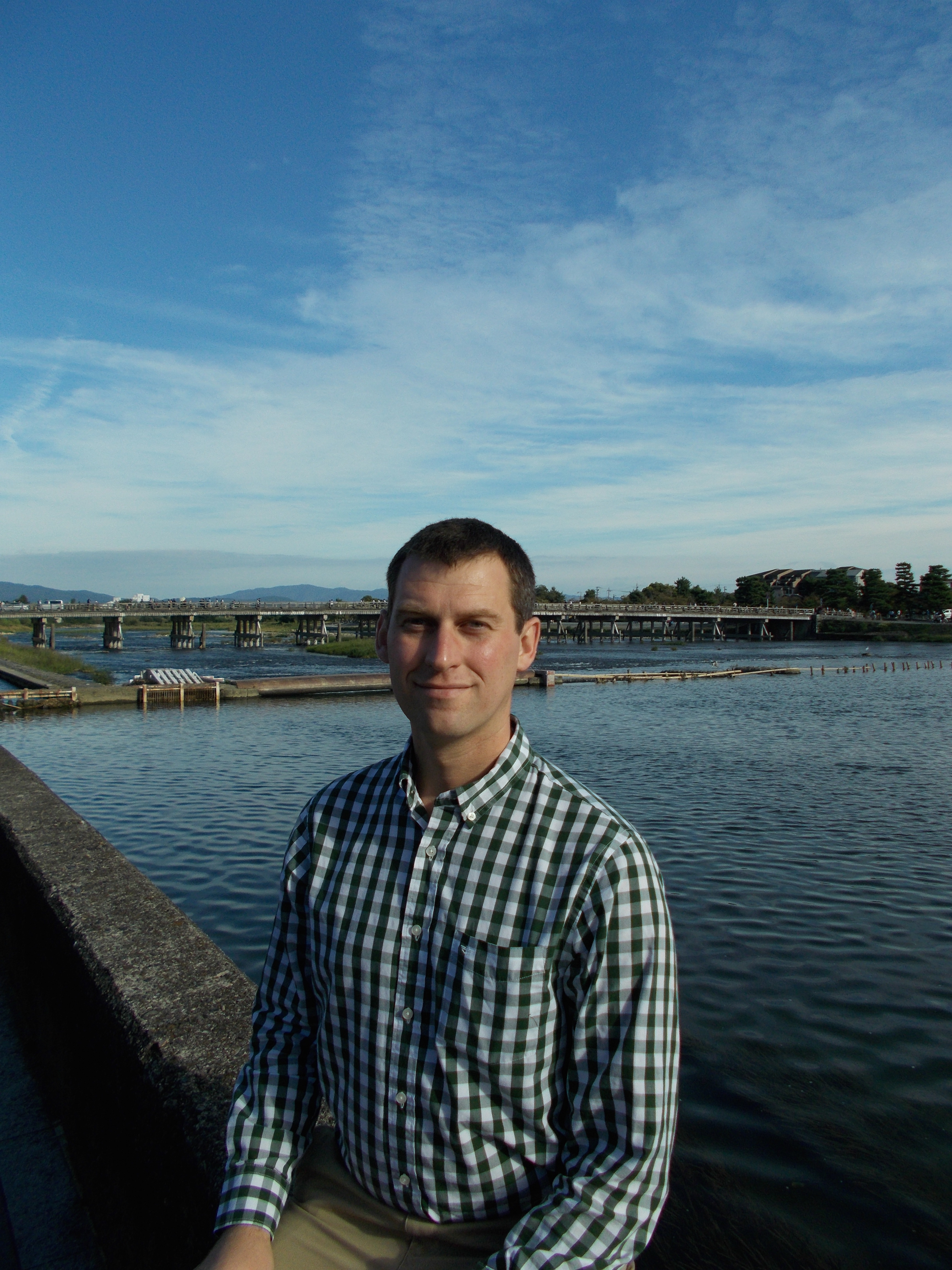
Aaron Johnson, PhD
Research Scientist
ajohns14@ou.edu
I am a Research Scientist in the Multiscale data-Assimilation and Predictability (MAP) Lab, led by professor Xuguang Wang. One of my main research interests is object-based post-processing and verification of probabilistic forecasts from convection permitting ensemble forecast systems. The object-based framework allows the ensemble forecasts to be objectively quantified in terms of specific storm modes and morphologies, consistent with how users often subjectively interact with such ensembles. Going forward, I am utilizing machine learning techniques to further calibrate the probabilistic forecasts of storm mode and conditional severe weather threats, using multi-scale ensemble diagnostics that include storm-object attributes, near storm environment parameters, mesoscale air-mass and synoptic scale flow characteristics.
During my post-doctoral research with Professor Wang, my research focused on understanding and improving the predictability of nocturnal convection. We designed and implemented a real-time convection permitting ensemble forecast system that was used in support of the PECAN (Plains Elevated Convection At Night) field campaign in the summer of 2015. PECAN highlighted the important role of atmospheric bores in the initiation and maintenance of nocturnal convection. I therefore also conducted several experiments aimed at better understanding practical predictability issues related to several bores observed during PECAN. My ongoing research is also building on past work investigating the optimal design of multi-scale ensemble initial condition perturbations.
I completed my B.S. with a double major in Meteorology and Computer Science at Valparaiso University before joing Dr. Wang's lab in 2009 as a Graduate Research Assistant where I completed my M.S. and PhD in Meteorology. For further information about my recent and ongoing research, please check out the Research link below and feel free to contact me about potential collaborations. I also enjoy mentoring both graduate and undergraduate students with similar research interests.
Selected Research Highlights
Top of Page
Object-based forecast diagnostics and verification
Newly developed object-based method of evaluating similarity between convective scale precipitation reveals that the strongest systematic clustering of the precipitation forecasts by microphysics scheme at early lead times vs. model core at later lead times (Johnson et al. 2011a,b).
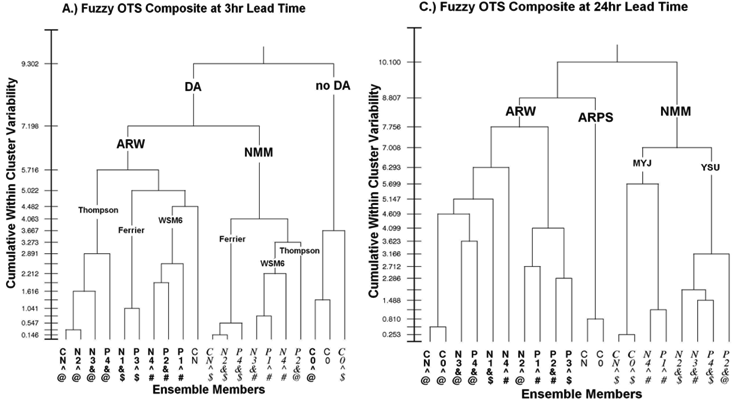
Impacts of model physics and resolution on atmospheric bore simulations
Impact of microphysics scheme on bore, as viewed by 1km AGL vertical velocity (Johnson et al. 2018).
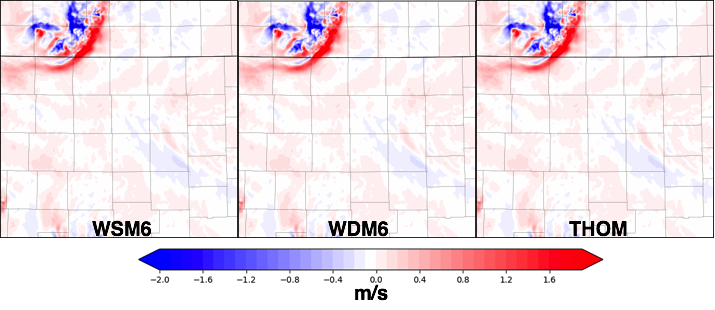
Cross-section view shows improved resolution of bore structure by increasing horizontal grid spacing of model, and turning of PBL parameterization. While the lower right panel was most similar to the detailed structure of the observed bore, the upscale impact on convective inhibition in the environment was resolved similarly well by the bore in the lower left panel, at reduced computational cost (Johnson and Wang 2019).
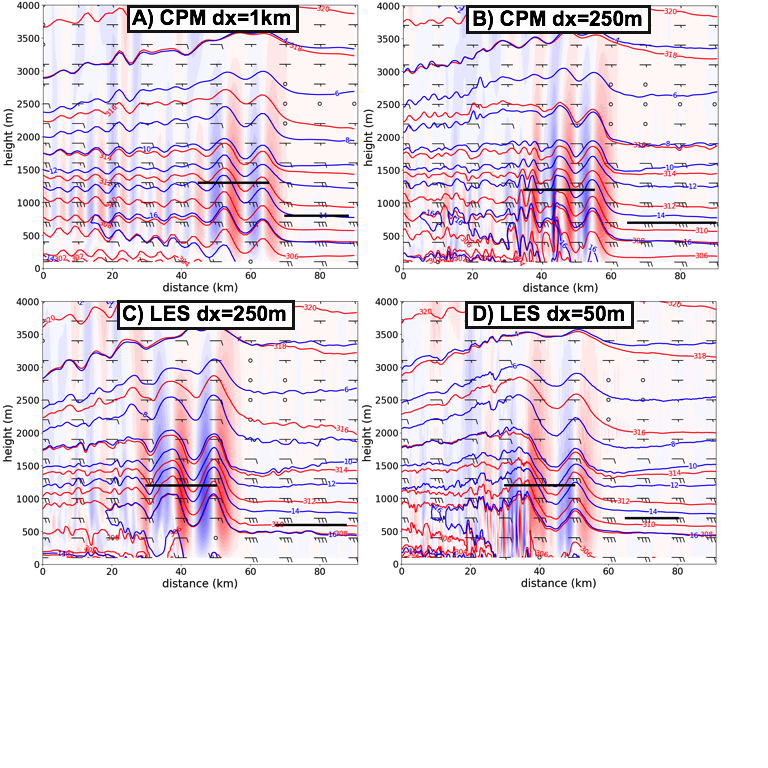
OSSE study of multiscale initial condition (IC) perturbations
IC perturbations generated with the multiscale DA system (center row) are more consistent with magnitude of ensemble mean analysis error (bottom row) than IC perturbations downscaled form a convection-parameterized resolution DA system (top row) in the vicinity of a Mesoscale Convective System. The IC perturbations in the top row systematically lead to spurious convective cells behind the primary MCS, as exemplified in panel a (Johnson and Wang 2016).
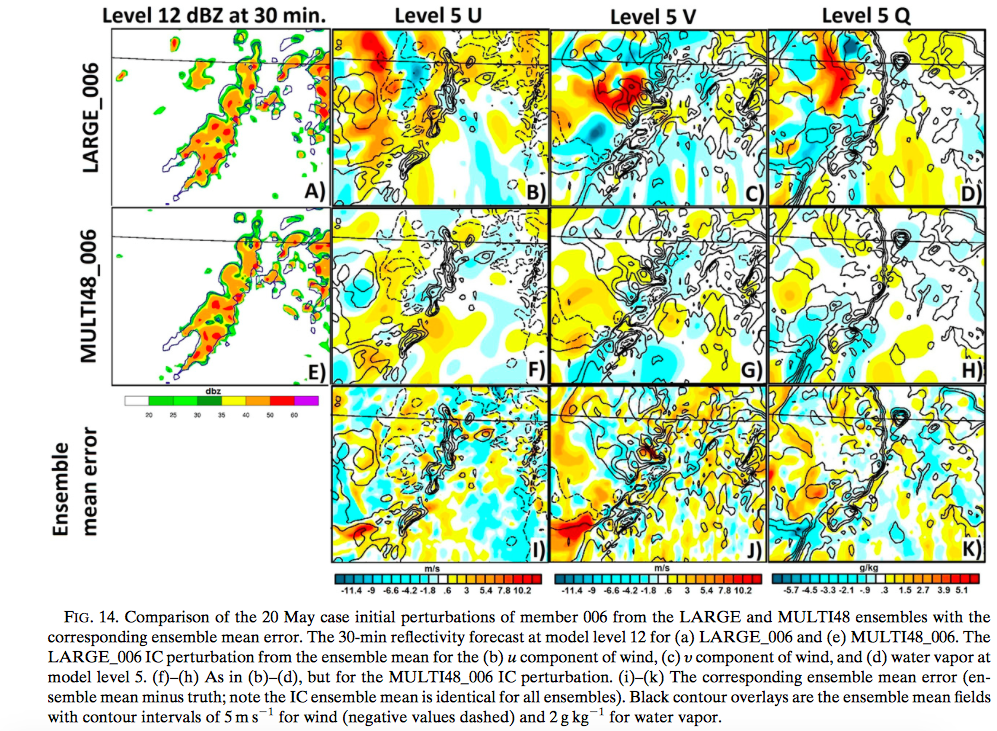
Publications
Top of Page
First-Author Publications
Johnson, A., X. Wang, 2019: Multicase assessment of the impacts of horizontal and vertical grid spacing, and turbulence closure model, on subkilometer-scale simulations of atmospheric bores during PECAN. Mon. Wea. Rev., 147, 1533-1555.
Johnson, A., X. Wang, K. R. Haghi, D. B. Parsons, 2018: Evaluation of forecasts of a convectively generated bore using an intensively observed case study from PECAN. Mon. Wea. Rev., 146, 3097-3122.
Johnson, A., X. Wang, S. Degelia, 2017: Design and implementation of a GSI-based convection-allowing ensemble based data assimilation and forecast system for the PECAN field experiment. Part 2: Overview and evaluation of real-time system. Wea. Forecasting.,32, 1227-1251.
Johnson, A., X. Wang, 2017: Design and implementation of a GSI-based convection-allowing ensemble data assimilation and forecast system for the PECAN field experiment. Part 1: Optimal configurations for nocturnal convection prediction using retrospective cases. Wea. Forecasting., 32, 289-315.
Johnson, A., X. Wang, 2016:A study of multiscale initial condition perturbation methods for convection-permitting ensemble forecasts. Mon. Wea. Rev., 144, 2579-2604.
Johnson, A., X. Wang, J. R. Carley, L. J. Wicker, C. Karstens, 2015: A comparison of multi-scale GSI-based EnKF and 3DVar data assimilation using radar and conventional observations for mid-latitude convective-scale precipitation forecasts. Mon. Wea. Rev., 143, 3087-3108.
Johnson, A., X. Wang, M. Xue, F. Kong, G. Zhao, Y. Wang, K. W. Thomas, K. A. Brewster and J. Gao, 2014: Multiscale characteristics and evolution of perturbations for warm season convection-allowing precipitation forecasts: Dependence on background flow and method of perturbation. Mon. Wea. Rev. 142, 1053-1073.
Johnson, A., X. Wang, F. Kong, M. Xue, 2013: Object-based evaluation of the impact of horizontal grid spacing on convection-allowing forecasts. Mon. Wea. Rev., 141, 3413-3425.
Johnson, A., X. Wang, 2013: Object-based evaluation of a storm-scale ensemble during the 2009 NOAA Hazardous Weather Testbed Spring Experiment. Mon. Wea. Rev., 141, 1079-1098.
Johnson, A., X. Wang, 2012: Verification and calibration of neighborhood and object-based probabilistic precipitation forecasts from a multi-model convection-allowing ensemble. Mon. Wea. Rev., 140, 3054-3077.
Johnson, A., X. Wang, M. Xue, and F. Kong, 2011b: Hierarchical cluster analysis of a convection-allowing ensemble during the Hazardous Weather Testbed 2009 Spring Experiment. Part II: Season-long ensemble clustering and implication for optimal ensemble design. Mon. Wea. Rev., 139, 3694-3710.
Johnson, A., X. Wang, F. Kong, M. Xue, 2011a: Hierarchical cluster analysis of a convection-allowing ensemble during the Hazardous Weather Testbed 2009 Spring Experiment. Part I: Development of object-oriented cluster analysis method for precipitation fields. Mon. Wea. Rev., 139, 3673-3693.
Coauthor Publications
Haghi, K. R., B. Geerts, H. G. Chipilski, A. Johnson, S. Degelia, D. Imy, D. B. Parsons, R. D. Adams-Selin, D. D. Turner, X. Wang, 2019: Bore-ing into nocturnal convection. Bull. Amer. Met. Soc., 100, 1103-1121.
Degelia, S., X. Wang, D. Stensrud and A. Johnson, 2017: Understanding the impact of radar and in-situ observations on the prediction of a nocturnal convection initiation event on 25 June 2013 using an ensemble-based multi-scale data assimilation system. Mon. Wea. Rev., 146, 1837-1859.
Jones, T., X. Wang, P. Skinner, A. Johnson, Y. Wang, 2017: Assimilation of GOES-13 imager clear-sky water vapor (6.5 um) radiances into a Warn-on-Forecast system. Mon. Wea. Rev., 146, 1077-1107.
Awards
Top of Page
2017 Early Career Travel Fellowship for 5th International Symposium on Earth-science Challenges in Kyoto, Japan
2014 OU Provost's Ph.D. Dissertation Award
2012 OU Faculty Recognition for Outstanding Performance as a Graduate Student Award
2011 OU SoM Yoshi K. Sasaki Award for Best M.S. Manuscript/Publication
2009/2010 AMS Graduate Fellowship




